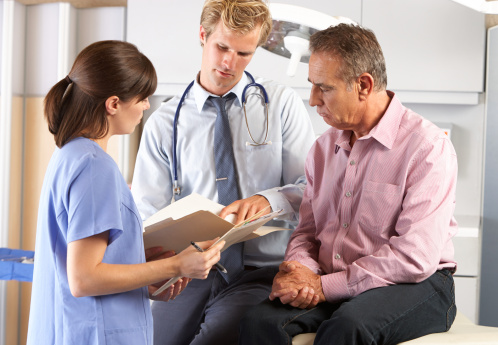Breast cancer not just a risk for women

When looking at the face of breast cancer, most assume it’s a face of a woman. But should men be talking about it too?
Breast health experts are also raising awareness of the disease and its effects on men too.
Dr. Heidi Memmel and Dr. Sally Friedewald, breast surgeons at Advocate Lutheran General Hospital’s Caldwell Breast Center in Park Ridge, Ill., say even though breast cancer affects a small minority of men, it’s still important to be aware of the risks.
“Men with a strong family history of breast or ovarian cancer can be at risk of carrying a BRCA mutation,” Dr. Memmel says. “If a man is a carrier of a BRCA mutation, his risk of developing breast cancer is approximately 8 percent in his lifetime. He is also at increased risk of developing other cancers, such as prostate cancer. “
Men at risk
According to the American Cancer Society, 2,190 men in the U.S. were expected to be diagnosed, and 410 expected to die from the disease in 2012. Additionally, the National Cancer Institute, says the average age of men diagnosed with breast cancer is between the ages of 60 and 70 years, though men of all ages can be diagnosed with the disease.
Dr. Memmel says men and women should consider genetic testing if they have a strong family history of breast and/or ovarian cancer, if they have Ashkenazi Jewish descent and are diagnosed with breast cancer, if there is a family history of male breast cancer or if a woman in the family is diagnosed with premenopausal breast cancer.
Symptoms and detection
Similar to women, men suffer from some of the same symptoms as women. Lumps in the breast area are the most identifiable symptom of breast cancer.
“Men should be aware of any changes in their breasts and should seek medical attention if they feel a new lump” Dr. Friedewald said.
Friedewald recommends men at risk to perform self breast examinations in the shower because the soap and water can make it easier.
“After the shower is a good time to look in the mirror for any skin changes including any dimpling or change in shape of the breasts,” she said.
According to Friedewald, most men come in with a problem and the breast is further evaluated with routine mammogram views as well as an ultrasound for further evaluation. A needle biopsy may be recommended if there is a suspicious mass.
Diagnosis and Treatment
Men tend to be diagnosed at a later stage because of decreased awareness of male breast cancer, Memmel said. Similar to women, although the cancer is often detected at a later stage and therefore may appear to have a worse prognosis treatment is available.
The doctors say typical treatment for male breast cancer may include:
- Mastectomy or lumpectomy
- Sentinel node biopsy
- Radiation, chemotherapy and endocrine therapy
“If you detect any of the symptoms or have questions, follow up with your physician as soon as possible,” said Dr. Memmel.
For more information on breast health, visit www.Storiesofthegirls.com.
Related Posts
Comments
About the Author
health enews staff is a group of experienced writers from our Advocate Health Care and Aurora Health Care sites, which also includes freelance or intern writers.

















